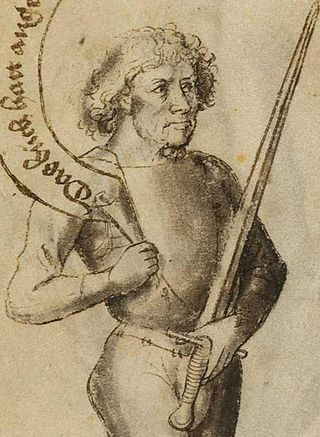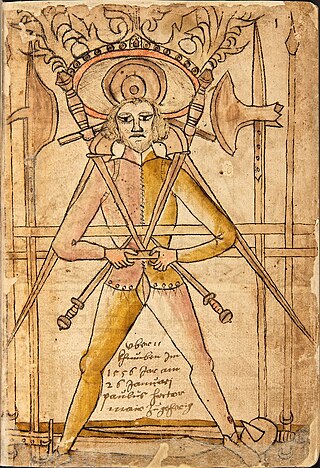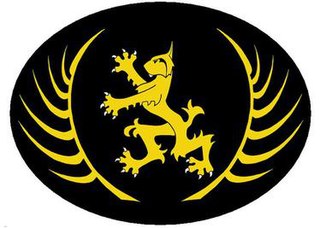
A longsword is a type of European sword characterized as having a cruciform hilt with a grip for primarily two-handed use, a straight double-edged blade of around 80 to 110 cm, and weighing approximately 1 to 1.5 kg.

Royal Armouries Ms. I.33 is the earliest known surviving European fechtbuch, and one of the oldest surviving martial arts manuals dealing with armed combat worldwide. I.33 is also known as the Walpurgis manuscript, after a figure named Walpurgis shown in the last sequence of the manuscript, and "the Tower manuscript" because it was kept in the Tower of London during 1950-1996; also referred to as British Museum No. 14 E iii, No. 20, D. vi.

Hans Talhoffer was a German fencing master. His martial lineage is unknown, but his writings make it clear that he had some connection to the tradition of Johannes Liechtenauer, the grand master of a well-known Medieval German school of fencing. Talhoffer was a well-educated man who took interest in astrology, mathematics, onomastics, and the auctoritas and the ratio. He authored at least five fencing manuals during the course of his career, and appears to have made his living teaching, including training people for trial by combat.

Fiore Furlano de Cividale d'Austria, delli Liberi da Premariacco was a late 14th century knight, diplomat, and itinerant fencing master.

Swordsmanship or sword fighting refers to the skills and techniques used in combat and training with any type of sword. The term is modern, and as such was mainly used to refer to smallsword fencing, but by extension it can also be applied to any martial art involving the use of a sword. The formation of the English word "swordsman" is parallel to the Latin word gladiator, a term for the professional fighters who fought against each other and a variety of other foes for the entertainment of spectators in the Roman Empire. The word gladiator itself comes from the Latin word gladius, which is a type of sword.

Johannes Liechtenauer was a German fencing master who had a great level of influence on the German fencing tradition in the 14th century.
Langort is a position in the German School of historical fencing. In the Langort position, the point of the sword is extended. The term appears first in Royal Armouries Ms. I.33.

Codex 3227a of the Germanisches Nationalmuseum in Nuremberg is a manuscript of 169 folia, dated to the close of the 14th century. Its text is written in Latin and German. The German portions have been identified as in East Central German dialect.

Historical European martial arts (HEMA) are martial arts of European origin, particularly using arts formerly practised, but having since died out or evolved into very different forms.
Martial arts manuals are instructions, with or without illustrations, specifically designed to be learnt from a book. Many books detailing specific techniques of martial arts are often erroneously called manuals but were written as treatises.

The German school of fencing is a system of combat taught in the Holy Roman Empire during the Late Medieval, German Renaissance, and Early Modern periods. It is described in the contemporary Fechtbücher written at the time. The geographical center of this tradition was in what is now Southern Germany including Augsburg, Frankfurt, and Nuremberg. During the period in which it was taught, it was known as the Kunst des Fechtens, or the "Art of Fighting". The German school of fencing focuses primarily on the use of the two-handed longsword; it also describes the use of many other weapons, including polearms, medieval daggers, messers, and the staff, as well as describing mounted combat and unarmed grappling (ringen).

Sigmund Schining ein Ringeck was a German fencing master. While the meaning of the surname "Schining" is uncertain, the suffix "ain Ringeck" may indicate that he came from the Rhineland region of south-western Germany. He is named in the text of his treatise as Schirmaister to one Duke Albrecht, Count Palatine of Rhine and Duke of Bavaria. Other than this, the only thing that can be determined about his life is that his renown as a master was sufficient for Paulus Kal to include him on his memorial to the deceased masters of the Society of Liechtenauer in 1470. Ringeck seems to have authored one of the few complete glosses of the epitome of the grand master Johannes Liechtenauer, making him one of the most important German fencing masters of the 15th century.

Cod. 44 A 8 also known as MS 1449, Bibliotheca dell'Academica Nazionale dei Lincei e Corsiniana, is a Fechtbuch compiled by Peter von Danzig in 1452. Danzig was a 15th-century German fencing master. He was counted among the 17 members of the "society of Johannes Liechtenauer".

The Gladiatoria Group is a series of several 15th-century German manuscripts that share the same art style and cover the same material—various types of armored combat. The texts are contemporary with the tradition of Johannes Liechtenauer, but not directly influenced by it. Gladiatoria is thus one of very few glimpses into the characteristics of a potentially independent German martial tradition.

The so-called Codex Wallerstein or Vonn Baumanns Fechtbuch is a 16th-century convolution of three 15th-century fechtbuch manuscripts, with a total of 221 pages.

MS 862 is the number in the nineteenth-century Donaueschingen catalogue of a South German fechtbuch dating to ca. 1500. It is influenced by Paulus Kal and Peter Falkner, and was in turn drawn upon by Jorg Wilhalm (1520s). The manuscript was up for auction at Sotheby's in 2005.

Joachim Meyer was a self described Freifechter living in the then Free Imperial City of Strasbourg in the 16th century and the author of a fechtbuch Gründtliche Beschreibung der Kunst des Fechtens first published in 1570.
Peter Falkner was a German fencing master, active in the late 15th century, influenced by Paulus Kal. He is the author of a fechtbuch, now KK 5012, at the Kunsthistorisches Museum, Vienna. He wrote treatises on the usage of longswords, messers, daggers, and on various other weapons of the time period

Gründtliche Beschreibung der Kunst des Fechtens or, in English: A Foundational Description of the Art of Fencing: A Thorough Description of the Free, Knightly and Noble Art of Fencing, Showing Various Customary Defenses, Affected and Put Forth with Many Handsome and Useful Drawings is a German fencing manual that was published in 1570. Its author was the Freifechter Joachim Meyer. This manual was made for and was dedicated to Meyer's patron Count Palatine Johann Casimir. This fechtbuch builds on his earlier work, a manuscript written in 1560 - the MS A.4°.2, and presents a complex, multi-weapon treatise. Meyer's complete system often marks the end of and the compilation of the German fencing system in the Johannes Liechtenauer tradition. It is the only fechtbuch in the Liechtenauer tradition that was written for both laymen and beginners of the art.

Schola Gladiatoria (SG) is a historical European martial arts (HEMA) group based in Ealing, west London, Great Britain, founded in 2001 and led by Matt Easton. It provides organized instruction in the serious study and practice of historical European swordplay. Schola seeks to be consistent with the methodology of the ancient European fencing schools by combining scholarship and research into the teachings of the historical masters, with the practical knowledge gained through solo and partnered drilling, and free play (sparring).
















